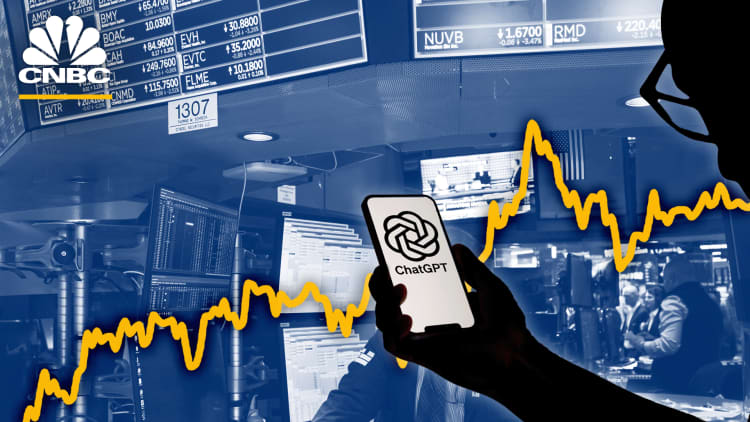
Jaap Arriens | Nurphoto | Getty Images
There has been much discussion in the financial media of late as to whether there’s another bubble forming in the publicly traded shares of companies involved in the development and use of artificial intelligence.
While it’s true that a handful of stocks have enjoyed powerful rallies, from Nvidia, Microsoft, Google-parent Alphabet, to Oracle and Adobe, the intense interest in Generative AI has not yet generated a bubble in said shares.
Let’s remember the elements of a bubble, as defined by many market historians who have written about such financial market phenomena (myself included).
Historians and economists such as Charles MacKay (“Some Extraordinary Delusions and the Madness of Crowds”), John Kenneth Galbraith (“The Great Crash, 1929”), Edward Chancellor (“Devil Take the Hindmost”) and Charles Kindleberger (“Manias, Panics and Crashes”), have written extraordinary books about the recurring tendency for investors to go crazy for stocks.

The bubble books chronicled everything from the 17th Century Dutch tulip mania to the South Sea and Mississippi Bubbles in England and France in the 18th Century to the Jazz Age craze for stocks in the “roaring 20s.”
They also include Japan’s stock and property bubbles in the 1980s, the internet frenzy in the 1990s and, most recently, the global real estate and credit bubble that caused the Great Financial Crisis in 2008.
In each case there were several common characteristics that defined the bubbles, from early disbelief that a particular asset or technology has transformational potential to wider acceptance, to rapid advances in asset prices and on to broad public participation in the mania coupled with massive issuance of stock by any company even marginally associated with the craze.
Lessons from the dotcom bubble
Yes, we’ve all very quickly come to believe in AI’s transformational potential, but only a handful of companies have been bid up in anticipation that generative AI will dramatically alter the way in which we work and live.
The public increasingly has been buying related tech stocks and associated ETFs, but we have yet to see the single-minded focus of the entire stock buying world come to bear on AI stocks.
With greater interest comes even much greater issuance until the supply of stocks participating in the bubble exceeds even the extreme demand among traders and investors.
In 1999 alone, some 456 stocks went public at the height of the internet mania. Some 77% of them had no profits. Indeed, in 1999, excluding the five biggest stocks in the Nasdaq 100, the P/E of the remainder topped 3,000%!
In my own bubble book, “TrendWatching,” I noted that in 1998 and ’99, “first day returns on IPOs exceeded 50%” while in 1999, one quarter of all IPOs doubled on their first day of trading.
As my colleague, David Faber, noted on CNBC earlier this week, companies like K-Tel, which sold music on late-night TV infomercials, soared from under $5 per share to over $30, just by announcing that it was converting to an internet-based strategy.
Like most other stocks, many with price/earnings ratios that were infinite, crashed, cratered and simply went out of business.
The Nasdaq Composite soared 85% in 1999, still a record annual gain for any U.S.-based index in a single calendar year. By 2003, it had plunged about 75%.
If there is to be a bubble in AI, it’s the early days.
Also, “easy money” from the Federal Reserve, a key component of financial frenzies, is not fueling speculation in publicly traded AI shares, or any other asset class for that matter.
The public is not yet all in. In other words, we ain’t there yet.
Bubbles are easy to spot
The gains have been concentrated, as we have seen, in five or six stocks. Granted, they have pushed the Nasdaq 100 up by 33% year-to-date, impressive to be sure, but this seems more like the so-called “Nifty 50” performance of cutting-edge companies in the early 1970s than it is like the internet bubble of the late 1990s.
Some experts say it’s impossible to identify a bubble while it’s inflating.
I would argue, after having covered several, they are actually pretty easy to spot. And, even more importantly, there is an enormous difference between a tiny bubble and a massive one.
The big bubbles that burst in the past crashed markets and, in some cases, entire economies, as happened in Japan in the 1990s or here in the U.S. after the real estate and credit crises nearly destroyed the entire financial system.
For now, AI is garnering much attention, a fair amount of investment dollars but not all of the available funds in finance.
That day may come when intelligent investors speculate on artificial intelligence without care for revenues or profits, focused just on potential.
When that day comes truly smart money will be separated from the dumb money as bets on intelligence become extremely unintelligent.
Commentary by Ron Insana, a CNBC and MSNBC contributor and the author of four books on Wall Street. Follow him on Twitter @rinsana.







